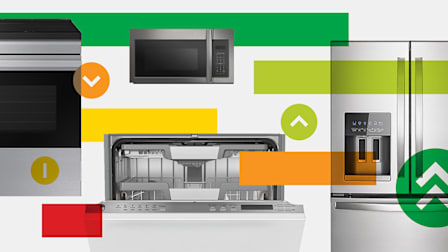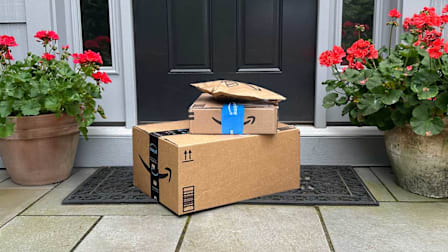Best Plastic Wrap
We tested eight brands of plastic wrap, including Kirkland Signature, Saran Wrap, and Stretch-Tite. One got gold stars across the board, but many more flunked.
When you shop through retailer links on our site, we may earn affiliate commissions. 100% of the fees we collect are used to support our nonprofit mission. Learn more.
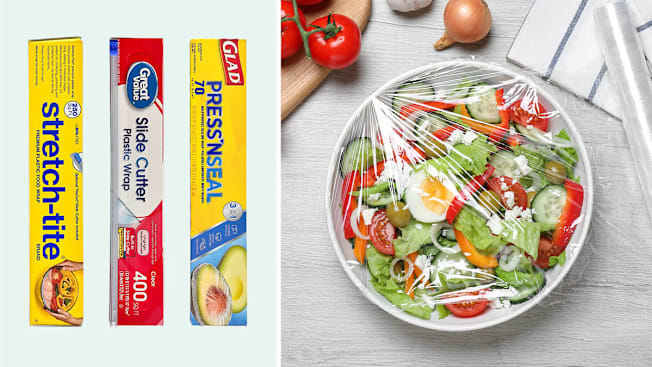
Two of my childhood friends were identical twins. Once your eyes settled on their subtle, but different, facial features, you could no longer imagine confusing one twin with the other. That’s how we felt after spending hours testing eight popular brands of plastic wrap in our labs. They may all purport to do the same thing, but some brands have as much in common as a dolphin does with a dog.
CR put plastic wraps through the wringer in our labs, using our tools to test their strength/tension and how easily they punctured. We also recruited several staffers to rip sheets of wrap from their packaging and tested how easily they leaked.
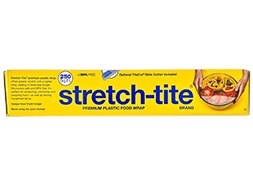
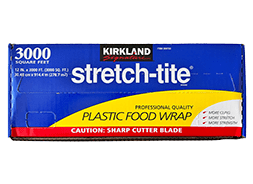
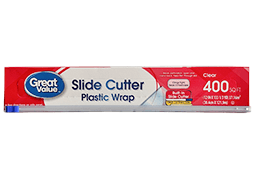
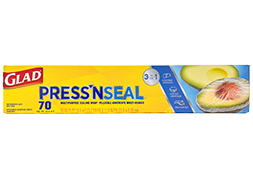
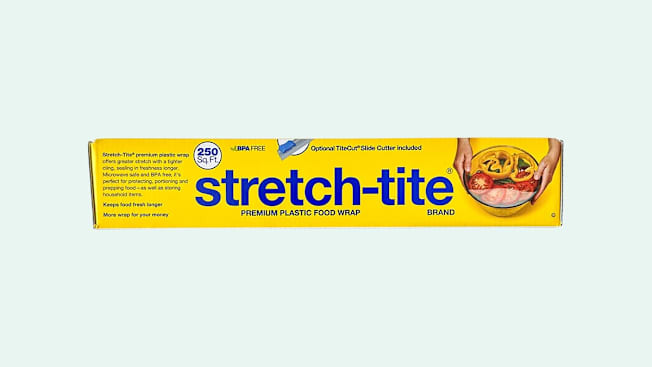
Pros: Strongest wrap we tested, rips cleanly, excellent adhesion, doesn’t leak.
Cons: Doesn’t handle chicken-pounding as well as we’d like.
If you use only one brand of plastic wrap for the rest of your life, make it Stretch-Tite. This one far exceeded the others in our lab stretch and tension tests, and the only other brand that came close to it in our puncture tests was our runner-up, Signature Kirkland. It adhered automatically to a glass bowl (with some of the wraps, we had to keep pushing down on the corners of the wrap to keep it in place, but this one stuck like glue), and removing and reapplying it was just fine—I could see getting a few uses out of one sheet before needing to discard it.
It passed our leakage test with flying colors, and it was a pleasure to remove it from its package, thanks to its built-in cutter that slid across the wrap like butter to cut it cleanly and evenly. “Perfect dispensing action—comes off the roll easily,” one of our testers, CR’s David Schipper, said. It’s also not a small detail that the wrap (like Kirkland Signature) pulls from the top of the box, and not toward you in the front of it, which made it so much easier to remove. A-plus design.
Spoiler alert: None of these wraps contained all of the chicken cutlet after we pounded it a few times, but this wrap was the best at it. A tiny piece of chicken poked out at the corner after nine or 10 poundings, so we recommend doubling up on the wrap when doing this.
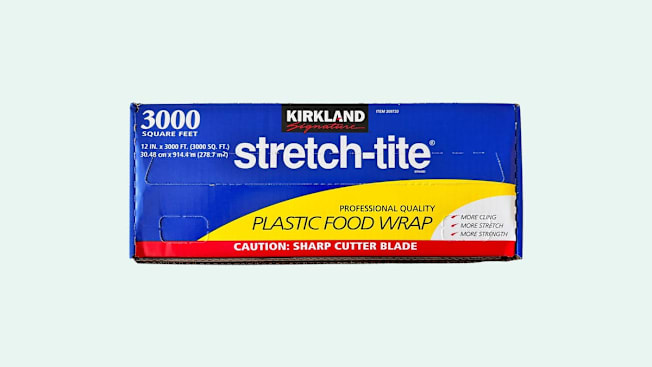
Pros: Didn’t puncture easily and comes in a big, sturdy box that stays put.
Cons: You’ll need room in your pantry to fit this wrap.
The first thing that stood out about this Costco brand was its comparatively huge package (3,000 square feet of wrap) that sits securely on a counter and never lifts or tips over. Its built-in cutter was a pain to assemble, and we found it didn’t slide as effortlessly as the Stretch-Tite, but unlike some of the others that didn’t rank in our tests, the slider didn’t get in the way of cutting the wrap, plus we liked how easy it was to pull the wrap through a slot at the top of the box.
This was the second-best wrap in our puncture tests and the third-best in our stretch/tension test (Glad, below, was second place). It didn’t leak, punctured only slightly when pounding chicken (double up your wrap), and adhered nicely to a glass bowl without needing to be held in place. Of course, its generous size means you’ll need enough room in your cabinet or pantry to store this one.
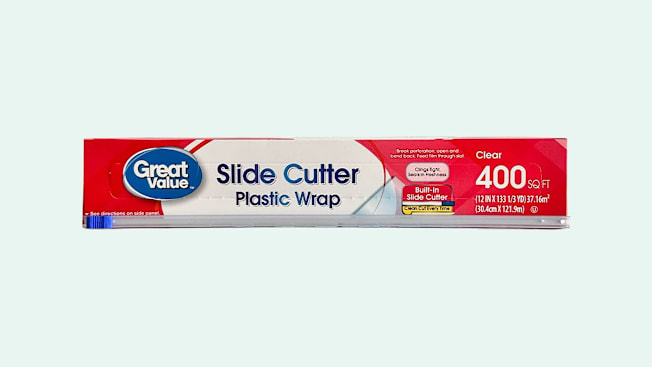
Pros: Amazing price, and its built-in cutter makes for easy use.
Cons: Flimsier than the other top choices.
If you can’t fathom spending more than $2 on plastic wrap, this one from Walmart is your best bet. You will have to make a few compromises, though. It was one of the flimsiest wraps we tested, though it was on a par with Stretch-Tite regarding how well it adhered to a bowl. Its strengths include its built-in cutter that makes removing it a breeze: “Super smooth cut, no issues with the cutter getting stuck,” CR’s Ginger Cowles said, though David said that he thought this slider was “less sturdy” than the other models.
It was absolutely awful at containing chicken when I pounded it—pieces of cutlet flew across the lab—so maybe don’t use it for that or layer your cutlet with a few pieces of wrap. Also, liquid is not its friend. It leaked a little when we wrapped it around a bowl of beans and its liquid, turned it upside down, and shook it.
You get what you pay for, but if you’re only looking for plastic wrap for basic kitchen needs, this one will suffice.
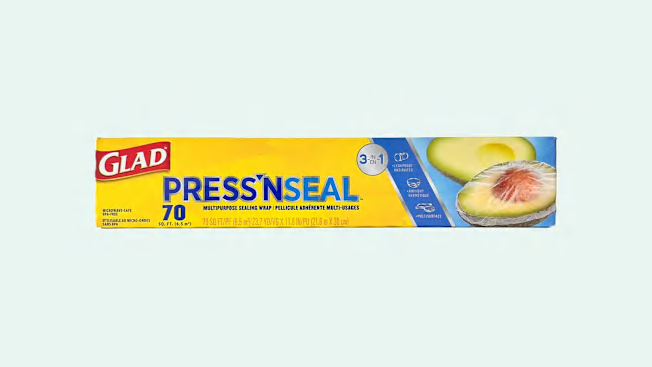
Pros: Best for reapplying and second-best in our puncture tests.
Cons: Removing the wrap from its package is a frustrating lesson in patience.
Removing this wrap from its roll made our testers lose it. “Who designed this? Awful. It sticks to itself, rips horribly, and crumbles together before you can even use it,” said CR’s Jodhaira Rodriguez. We wished Glad had included design details like a built-in slide cutter or even a sticky restart strip to keep the wrap from adhering to itself, and these misses affected its ease of use in a way that might keep customers from repurchasing it.
That’s a shame because the wrap adhered to our bowl like a dream, and after I removed it and reapplied it five times, it maintained its original structure. It didn’t rip or fold in on itself, something that made other wraps impossible to reuse. This wrap didn’t leak and was the second strongest in our strength/tension test and the third strongest in our puncture test. If a redesign comes along that adds features to its packaging to make it less of a nightmare to rip off, we’ll be first in line to try it again.
Other Plastic Wraps We Tested
The rest of the wraps we tested simply weren’t as strong or easy to remove from their packaging. Some leaked, and others were dismal at handling a chicken cutlet pounding.
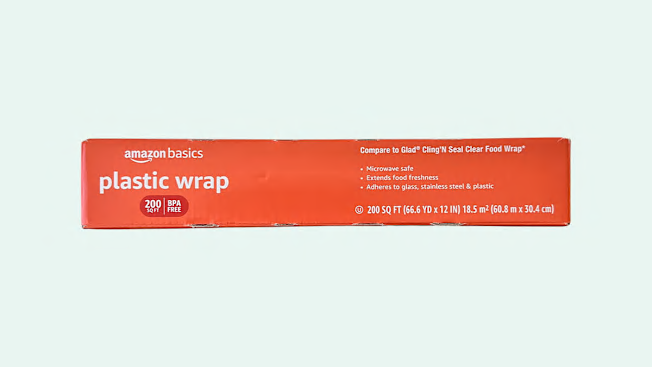
This was the second wrap that caused chicken cutlet goo to launch from one part of the lab to the other during our pounding test. We could forgive that if the wrap were stronger, but it was the second weakest in our strength/tension test and fell in the middle in our puncture test. It didn’t adhere effortlessly to the bowl (I did my fair share of smoothing it down at the ends with my fingers), and it ripped a little when I tried to reapply it.
We appreciate that the package has a restart strip to keep wrap from sticking to itself, but our testers became frustrated with how the box sometimes lifts when you’re tearing out a sheet, and its lack of a built-in slider means sheets cut inconsistently. The price is nice, but Great Value is less expensive and better overall.
We used an omelet skillet to pound plastic-wrapped chicken cutlets. Some brands, including Great Value, Amazon Basics, and Up&Up tore almost immediately, leaving chicken exposed.
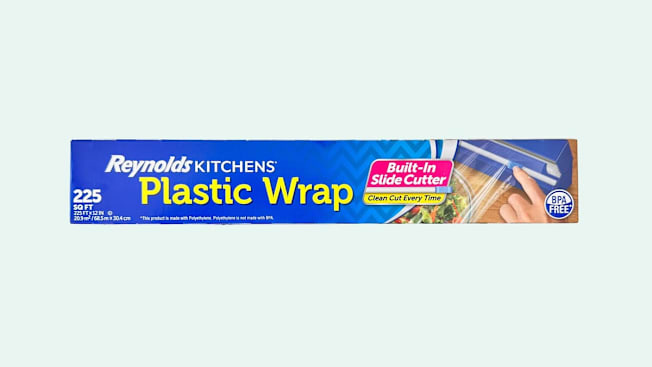
We expected more from a name like Reynolds Kitchens. Its strengths included a built-in cutter and “grip strip” that made it easier than most to tear off the wrap. “Not the worst, but also not the best,” Jodhaira said. “I felt like the slider was hard to unlock."
Other pros include that it didn’t leak and fewer chicken parts tore through the wrap when we pounded it than some others. However, it was the weakest in our strength/tension test and the second weakest in our puncture test. Our overall feeling about this wrap is that it’s just “okay.”
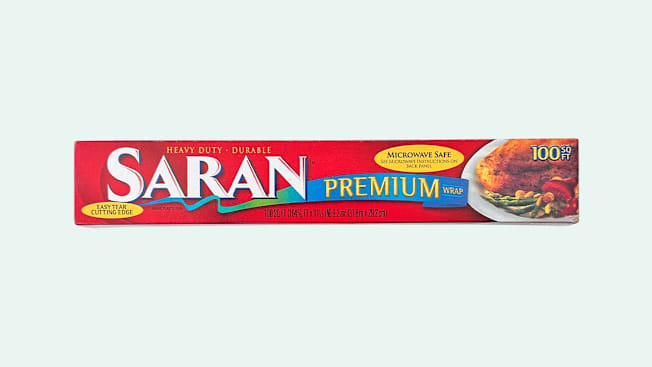
Saran Premium Wrap was another one we had high hopes for, but it didn’t perform well in our strength/tension and puncture tests, and it leaked a little. It felt stickier than Reynolds and stayed adhered to our bowl without much work, plus the restart strip on its box made removing the wrap a little easier, but its lack of a built-in cutter affected how cleanly and evenly each piece ripped. It wasn’t the best or worst wrap, but it’s worth mentioning that, aside from the Glad wrap, this one comes with the least amount of wrap per package.
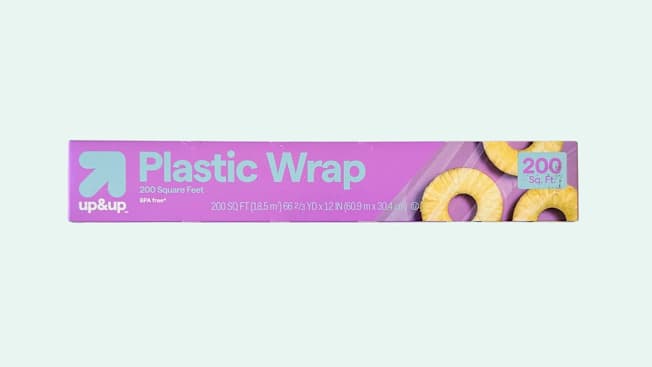
“This rips really cleanly, but when I pull it out, it makes the whole roll come out of the box, which is so annoying,” Jodhaira said. “I’d never buy this.”
Aside from a restart strip on the box, this Target-brand plastic wrap lacks features that help make it less frustrating to rip off, and from there, its features don’t improve much. While it’s true that it’s the best of the worst in our strength/tension and puncture tests, the reason why it didn’t rank above Great Value as a bargain pick is that Great Value blew it out of the water when it came to ease of use and ripping wrap from the package.
Up&Up was also less adhesive on our bowl, leaked a little, and was the worst in our chicken cutlet pounding test—as soon as I began pounding, a big hole tore on the left side, leaving almost half of the cutlet exposed. This wrap may work fine in a pinch, but an everyday essential like plastic wrap shouldn’t be this frustrating.
Is Plastic Wrap Safe to Use?
Plastic is a problem. We understand that using plastic wrap can feel risky, so let’s address the elephant in the room. There’s too much plastic in our environment, in our food, and in our bodies. There is evidence that most plastic products contain chemicals that can disrupt the endocrine or hormone system, and are linked to metabolic disorders, reproductive issues, and more.
According to their manufacturers, all the plastic wraps we tested are free of Bisphenol A (BPAs), and several say they are “microwave-safe.” However, CR recommends not microwaving plastic or using plastic to store hot food because the heat can cause plastic to leach. Best practices when using plastic wrap include not allowing plastic wrap to come into contact with food (especially when heating or when the food has a high fat content). When wrapping food in a bowl or container, leave a space between the food and the wrap itself.
If you want to explore other food storage options, CR tested glass, stainless steel, and silicone food storage containers.
How We Tested Plastic Wrap
We used a force gauge to test all the wraps for strength/tension and how easily they puncture the wrap. Five CR testers tested ease of use and design features by ripping wrap from their packages at least twice in a row, and sometimes more. We filled glass bowls with beans and water, tested how well each wrap adhered to the bowl, and whether it could be removed and reapplied. We then turned the bowls over and shook them for about 20 seconds to see if liquid leaked through the wraps. Finally, we wrapped one small chicken cutlet with a wrap, rolled it twice in the wrap, and folded the wrap inwards (like an envelope), and pounded the cutlet with a small skillet to test how well it stayed intact in the wrap.


















